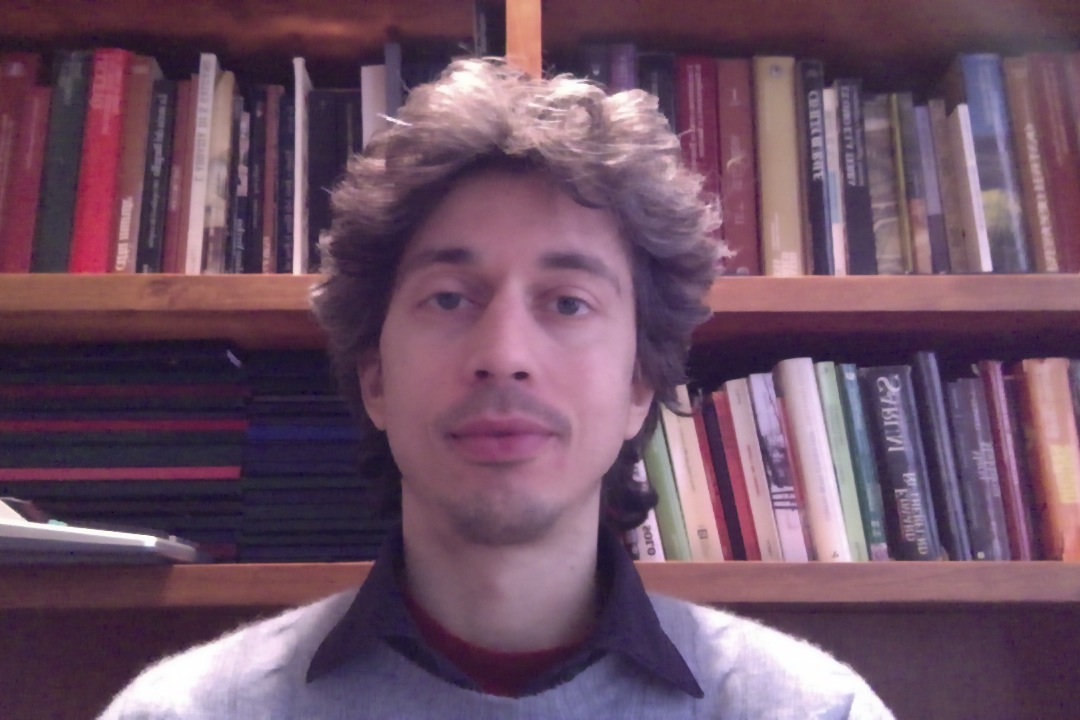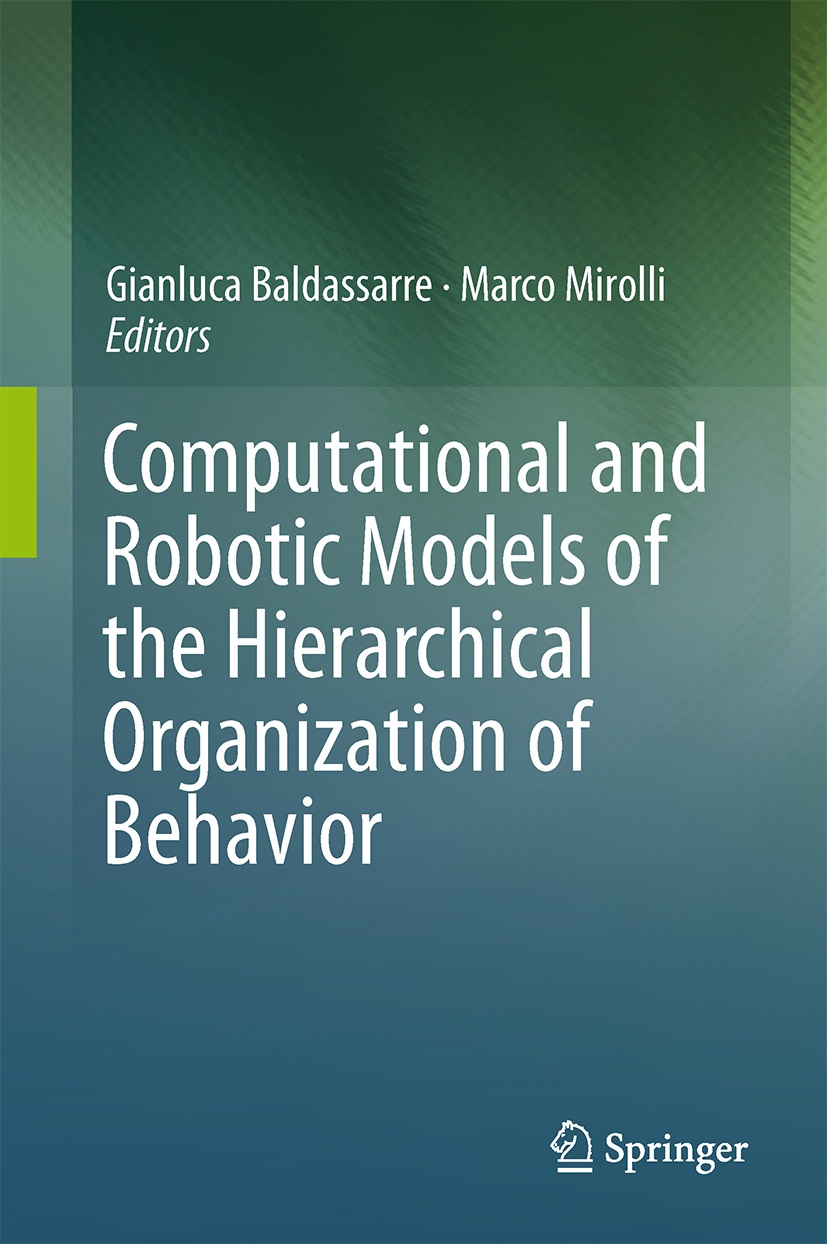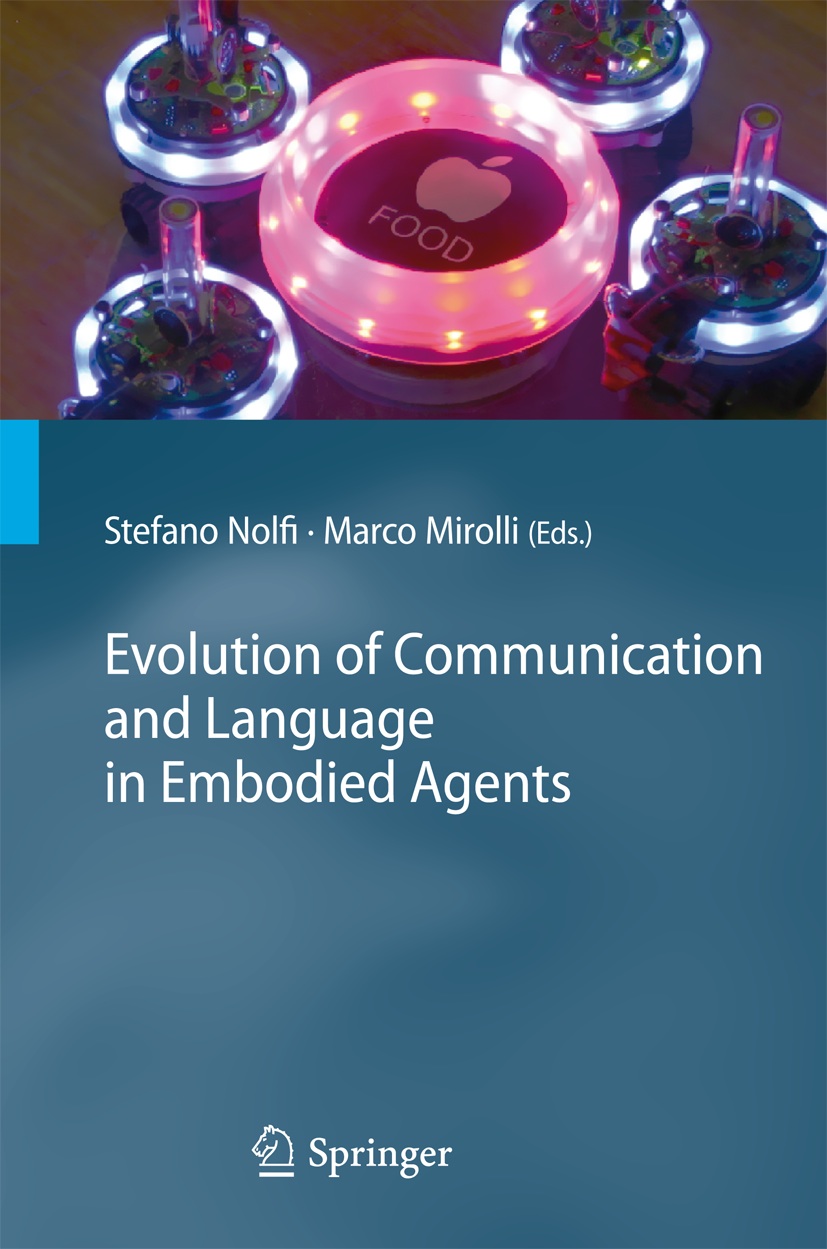Most publications are downloadable (e-prints).
Originals can be found through the doi link.
For publications statistics, see my Google Scholar profile
Edited Volumes
- Cagnoni Stefano, Mirolli Marco, Villani Marco (2014): Evolution, Complexity and Artificial Life, Berlin:
Springer .
doi: 10.1007/978-3-642-37577-4 - Baldassarre Gianluca, Mirolli Marco (2013): Intrinsically Motivated Learning in Natural and Artificial Systems, Berlin:
Springer .
doi: 10.1007/978-3-642-32375-1 - Baldassarre Gianluca, Mirolli Marco (2013): Computational and Robotic Models of the Hierarchical Organization of Behavior, Berlin:
Springer .
doi: 10.1007/978-3-642-39875-9 - Baldassarre Gianluca, Barto Andrew, Mirolli Marco, Redgrave Peter, Ryan Richard M., Stafford Tom (2013): Intrinsic motivations and open-ended development in animals, humans, and robots, Frontiers Research Topic. Cross-listed in Frontiers in Psychology (Cognitive Science Section) and Frontiers in Neurorobotics
- Nolfi Stefano, Mirolli Marco (2010): Evolution of Communication and Language in Embodied Agents, Berlin:
Springer .
doi: 10.1007/978-3-642-01250-1 - Baldassarre Gianluca, Marocco Davide, Mirolli Marco (2006): La via italiana alla vita artificiale, special issue of
Sistemi Intelligenti , 1 (Italian)
Journal papers
- Tommasino Paolo, Caligiore Daniele, Mirolli Marco, Baldassarre Gianluca (in press) A Reinforcement Learning Architecture that Transfers Knowledge between Skills when Solving Multiple Tasks,
IEEE Transactions on Cognitive and Developmental Systems - Mannella Francesco, Mirolli Marco, Baldassarre Gianluca (2016) Goal-directed behaviour and instrumental devaluation: a neural system-level computational model,
Frontiers in Behavioral Neuroscience , 220(3): 1339-1353
doi: 10.3389/fnbeh.2016.00181 - Santucci Vieri Giuliano, Baldassarre Gianluca, Mirolli Marco (2016) GRAIL: a Goal-discovering Robotic Architecture for Intrinsically-motivated Learning,
IEEE Transactions on Cognitive and Developmental Systems , 8(3): 214-231
doi: 10.1109/TCDS.2016.2538961 - Fiore Vincenzo G., Mannella Francesco, Mirolli Marco, Latagliata Emanuele Claudio, Valzania Alessandro, Cabib Simona, Dolan Raymond J., Puglisi-Allegra Stefano, Baldassarre Gianluca (2015) Corticolimbic catecholamines in stress: a computational model of the appraisal of controllability,
Brain Structure and Function , 220(3): 1339-1353
doi: 10.1007/s00429-014-0727-7 - Addessi Elsa, Albano Mariangela, De Petrillo Francesca, Laviola Giovanni, Mirolli Marco, Paglieri Fabio, Parisi Domenico, Petrosino Giancarlo, Ventricelli Marialba, Zoratto Francesca, Adriani Walter (2015) Basi neurobiologiche del gioco d’azzardo: il contributo integrato di psicobiologia, etologia cognitiva e robotica.
Sistemi Intelligenti , 27(3), 561–614 (Italian)
doi: 10.1422/82226 - Baldassarre Gianluca, Stafford Tom, Mirolli Marco, Redgrave Peter, Ryan Richard M., Barto Andrew (2014) Intrinsic motivations and open-ended development in animals, humans, and robots: an overview.
Frontiers in Psychology , 5:985
doi: 10.3389/fpsyg.2014.00985 - Gigliotta Onofrio, Mirolli Marco, Nolfi Stefano (2014) Communication based dynamic role allocation in a group of homogeneous robots,
Natural Computing , 13: 391-402
doi: 10.1007/s11047-014-9443-8 - Taffoni Fabrizio, Tamilia Eleonora, Focaroli Valentina, Formica Domenico, Ricci Luca Di Pino Giovanni, Baldassarre Gianluca, Mirolli Marco, Guglielmelli Eugenio, Keller Flavio (2014) Development of goal-directed action selection guided by intrinsic motivations: an experiment with children
Experimental Brain Research , 232(7): 2167-2177
doi: 10.1007/s00221-014-3907-z - Polizzi di Sorrentino Eugenia, Sabbatini Gloria, Truppa Valentina, Bordonali Anna, Taffoni Fabrizio, Formica Domenico, Baldassarre Gianluca, Mirolli Marco, Guglielmelli Eugenio, Visalberghi Elisabetta (2014) Exploration and learning in capuchin monkeys (Sapajus spp.): the role of action-outcome contingencies,
Animal Cognition , 17(5): 1081-1088
doi: 10.1007/s10071-014-0740-5 - Paglieri Fabio, Addessi Elsa, De Petrillo Francesca, Laviola Giovanni, Mirolli Marco, Parisi Domenico, Petrosino Giancarlo, Ventricelli Marialba, Zoratto Francesca, Adriani Walter (2014) Nonhuman gamblers: Lessons from rodents, primates, and robots,
Frontiers in Behavioral Neuroscience , 8:33
doi: 10.3389/fnbeh.2014.00033 - Fiore Vincenzo G., Sperati Valerio, Mannella Francesco, Mirolli Marco, Gurney Kevin, Friston Karl, Dolan Rayamond J., Baldassarre Gianluca (2014) Keep focussing: striatal dopamine multiple functions resolved in a single mechanism tested in a simulated humanoid robot,
Frontiers in Psychology 5:124
doi: 10.3389/fpsyg.2014.00124 - Santucci Vieri G., Baldassarre Gianluca, Mirolli Marco (2013) Which is the best intrinsic motivation signal for learning multiple skills?,
Frontiers in Neurorobotics , 7:22
doi: 10.3389/fnbot.2013.00022 - Barto Andrew, Mirolli Marco, Baldassarre Gianluca (2013). Novelty or Surprise?,
Frontiers in Psychology , 4:907
doi: 10.3389/fpsyg.2013.00907 - Mirolli Marco, Santucci Vieri, Baldassarre Gianluca (2013): Phasic dopamine as a prediction error of intrinsic and extrinsic reinforcements driving both action acquisition and reward maximization: A simulated robotic study,
Neural Networks , 39: 40-51
doi: dx.doi.org/10.1016/j.neunet.2012.12.012 - Baldassarre Gianluca, Mannella Francesco, Fiore Vincenzo G., Redgrave Peter, Gurney Kevin, Mirolli Marco (2013): Intrinsically motivated action-outcome learning and goal-based action recall: A system-level bio-constrained computational model,
Neural Networks , 41: 168-187
doi: 10.1016/j.neunet.2012.09.015 - Chersi Fabian, Mirolli Marco, Pezzulo Giovanni, Baldassarre Gianluca (2013): A spiking neuron model of the cortico-basal ganglia circuits for goal-directed and habitual action learning,
Neural Networks , 41: 212-224
doi: 10.1016/j.neunet.2012.11.009 - Mirolli Marco (2012): Representations in Dynamical Embodied Agents: Re-Analyzing a Minimally Cognitive Model Agent,
Cognitive Science , 36: 870-895.
doi: 10.1111/j.1551-6709.2012.01233.x - Taffoni Fabrizio, Vespignani Massimo, Formica Domenico, Cavallo Giuseppe, Polizzi di Sorrentino Eugenia, Sabbatini Gloria, Truppa Valentina, Mirolli Marco, Baldassarre Gianluca, Visalberghi Elisabetta, Keller Flavio, Guglielmelli Eugenio (2012): A mechatronic platform for behavioral analysis on nonhuman primates,
Journal of Integrative Neuroscience , 11(1): 87-101.
doi: 10.1142/S0219635212500069 - Mirolli Marco, Parisi Domenico (2011): La societa' nella mente (attraverso il linguaggio),
Sistemi Intelligenti , 2: 309-317 (Italian).
doi: 10.1422/35357 - Mirolli Marco, Parisi Domenico (2011): Towards a Vygotskyan Cognitive Robotics: The Role of Language as a Cognitive Tool,
New Ideas in Psychology , 29: 298-311.
doi: 10.1016/j.newideapsych.2009.07.001 - Mirolli Marco, Tomassino Ferrauto, Stefano Nolfi (2010): Categorisation through Evidence Accumulation in an Active Vision System,
Connection Science , 22(4): 331-354.
doi: 10.1080/09540091.2010.505976 - Mirolli Marco, Mannella Francesco, Baldassarre Gianluca (2010): The Roles of The Amygdala in the Affective Regulation of Body, Brain, and Behaviour,
Connection Science , 22(3): 215-245.
doi: 10.1080/09540091003682553 - Baldassarre Gianluca, Mirolli Marco (2010): What are the Key Open Challenges for Understanding Autonomous Cumulative Learning of Skills?,
Autonomous Mental Development Newsletter , 7(2): 2-9 (target column with commentaries and response). - Mirolli Marco, Parisi Domenico (2009): Language as a Cognitive Tool,
Minds and Machines , 19(4): 517-528.
doi: 10.1007/s11023-009-9174-2 - Mirolli Marco, Parisi Domenico (2008): How producer biases can favor the evolution of communication: An analysis of evolutionary dynamics,
Adaptive Behavior , 16(1): 27-52.
doi: 10.1177/1059712307087597 - Mirolli Marco (2006) Vita artificiale e linguaggio,
Sistemi Intelligenti , 1: 133-142 (Italian).
doi: 10.1422/21798 - Baldassarre Gianluca, Marocco Davide, Mirolli Marco (2006): La via italiana alla vita artificiale,
Sistemi Intelligenti , 1: 3-6 (Italian).
doi: 10.1422/21783 - Mirolli Marco, Parisi Domenico (2005): How can we explain the emergence of a language that benefits the hearer but not the speaker?
Connection Science , 17(3-4): 307-324.
doi: 10.1080/09540090500177539 - Mirolli Marco (2002): A naturalistic perspective on intentionality. Interview with Daniel Dennett,
Mind & Society , 6 (3): 1-12.
doi: 10.1007/BF02513145
Book chapters and Conference Proceedings
- Santucci Vieri G., Baldassarre Gianluca, Mirolli Marco (2014): Autonomous selection of the “what” and the “how” of learning: an intrinsically motivated system tested with a two armed robot:
Proceedings of the IEEE International Conference on Development and Learning and Epigenetic Robotics (ICDL-EpiRob2014) : 1-6. - Gigliotta Onofrio, Mirolli Marco (2014): Evolution of communication-based collaborative behavior in homogeneous robots. In Sayama H., Rieffel J., Risi S., Doursat R., Lipson H. (Eds.)
Artificial Life 14. Proceedings of the Fourteenth International Conference on the Synthesis and Simulation of Living Systems . Cambridge MA, MIT Press: 673-680. - Santucci Vieri G., Baldassarre Gianluca, Mirolli Marco (2014) Cumulative learning through intrinsic reinforcements. In S. Cagnoni, M.Mirolli, M. Villani (eds.):
Evolution, Complexity and Artificial Life . Berlin: Springer: 107-122 - Mirolli Marco, Baldassarre Gianluca (2013): Functions and Mechanisms of Intrinsic Motivations: The Knowledge vs. Competence Distinction. In Baldassarre G. and Mirolli M. (Eds.)
Intrinsically Motivated Learning in Natural and Artificial Systems . Berlin, Springer Verlag: 49-72. - Baldassarre Gianluca, Mirolli Marco (2013): Deciding Which Skill to Learn When: Temporal-Difference Competence-Based Intrinsic Motivation (TD-CB-IM). In Baldassarre G. and Mirolli M. (Eds.)
Intrinsically Motivated Learning in Natural and Artificial Systems . Berlin, Springer Verlag: 257-278. - Fabrizio Taffoni, Domenico Formica, Giuseppina Schiavone, Maria Scorcia, Alessandra Tomassetti, Eugenia Polizzi di Sorrentino, Gloria Sabbatini, Valentina Truppa, Francesco Mannella, Vincenzo Fiore, Marco Mirolli, Gianluca Baldassarre, Elisabetta Visalberghi, Flavio Keller, and Eugenio Guglielmelli (2013): The “Mechatronic Board”: A Tool to Study Intrinsic Motivations in Humans, Monkeys, and Humanoid Robots. In Baldassarre G. and Mirolli M. (Eds.)
Intrinsically Motivated Learning in Natural and Artificial Systems . Berlin, Springer Verlag: 411-432. - Baldassarre Gianluca, Mirolli Marco (2013): Intrinsically Motivated Learning Systems: An Overview. In Baldassarre G. and Mirolli M. (Eds.)
Intrinsically Motivated Learning in Natural and Artificial Systems . Berlin, Springer Verlag: 1-14. - Baldassarre Gianluca, Mirolli Marco (2013): Computational and Robotic Models of the Hierarchical Organization of Behavior: An Overview. In Baldassarre G. and Mirolli M. (Eds.)
Computational and Robotic Models of the Hierarchical Organization of Behavior . Berlin, Springer Verlag: 1-10. - Santucci Vieri Giuliano, Baldassarre Gianluca, Mirolli Marco (2013): Intrinsic motivation signals for driving the acquisition of multiple tasks: A simulated robotic study. In R.L. West, T.C. Stewart (Eds.):
Proceedings of the 12th International Conference on Cognitive Modelling (ICCM2013) . Carleton University: 59-64 - Santucci Vieri Giuliano, Baldassarre Gianluca, Mirolli Marco (2012): A bio-inspired learning signal for the cumulative learning of different skills. In Cagnoni Stefano, Mirolli Marco and Villani Marco (Eds.):
Proceedings of the Italian Workshop of Artificial Life and Evolutionary Computation (WIVACE2012) . Dip. Scienze Sociali. Universita' di Parma: E1-12 - Tommasino Paolo, Caligiore Daniele, Mirolli Marco, Baldassarre Gianluca (2012): Reinforcement Learning Algorithms that Assimilate and Accommodate Skills with Multiple Tasks:
Proceedings of the IEEE International Conference on Development and Learning and Epigenetic Robotics (ICDL-EpiRob2012) : 1-6 - Santucci Vieri Giuliano, Baldassarre Gianluca, Mirolli Marco (2012): Intrinsic Motivation Mechanisms for Competence Acquisition.
Proceedings of the IEEE International Conference on Development and Learning and Epigenetic Robotics (ICDL-EpiRob2012) : 1-6 - Taffoni Fabrizio, Formica Domenico, Zompanti Alessandro, Mirolli Marco, Balsassarre Gianluca, Keller Flavio, Guglielmelli Eugenio (2012): A Mechatronic Platform for Behavioral Studies on Infants.
Proceedings of The Fourth IEEE RAS/EMBS International Conference on Biomedical Robotics and Biomechatronics (BioRob2012) - Santucci Vieri Giuliano, Baldassarre Gianluca, Mirolli Marco (2010): Biological cumulative learning requires intrinsic motivation: A simulated robotic study on the development of visually-guided reaching. In Johansson Birger, Sahin Erol and Balkenius Christian (Eds.):
Proceedings of the Tenth International Conference on Epigenetic Robotics (EpiRob2010) . Lund, Lund University Cognitive Studies (149) - Caligiore Daniele, Mirolli Marco, Parisi Domenico, Baldassarre Gianluca (2010): A Bioinspired Hierarchical Reinforcement Learning Architecture for Modeling Learning of Multiple Skills with Continuous States and Actions. In Johansson Birger, Sahin Erol and Balkenius Christian (Eds.):
Proceedings of the Tenth International Conference on Epigenetic Robotics (EpiRob2010) . Lund, Lund University Cognitive Studies (149) - Mannella Francesco, Mirolli Marco, Baldassarre Gianluca (2010): The interplay of pavlovian and instrumental processes in devaluation experiments: a computational embodied neuroscience model tested with a simulated rat. In Tosh C.R. and Ruxton G.D. (Eds.):
Modelling Perception with Artificial Neural Networks . Cambridge, Cambridge University press: 93-113 - Mirolli Marco, Nolfi Stefano (2010): Evolving communication in embodied agents: Theory, Methods, and Evaluation. In Nolfi S. and Mirolli M. (Eds.):
Evolution of Communication and Language in Embodied and Situated Agents . Berlin, Springer Verlag: 105-121 - Mirolli Marco, Parisi Domenico (2010): Producer Biases and Kin Selection in the Evolution of Communication: How the Phylogenetic and the Adaptive Problems of Communication can be solved. In Nolfi S. and Mirolli M. (Eds.):
Evolution of Communication and Language in Embodied and Situated Agents . Berlin, Springer Verlag: 135-159 - Nolfi Stefano, Mirolli Marco (2010): Evolving communication in embodied agents: Assessment and Open Challenges. In Nolfi S. and Mirolli M. (Eds.):
Evolution of Communication and Language in Embodied and Situated Agents . Berlin, Springer Verlag: 215-220 - Ferrauto Tomassino, Tuci Elio, Mirolli Marco, Massera Gianluca, Nolfi Stefano (2009): Two examples of active categorisation processes distributed over time. In L. Cañamero, P-Y. Oudeyer, C. Balkenius (Eds.),
Proceedings of the Ninth International Conference on Epigenetic Robotics . Lund, Lund University Cognitive Studies 146: 49-56 - Tummolini Luca, Mirolli Marco, Castelfranchi Cristiano (2009): The Evolution of Stigmergy: A Simulative Approach to Indirect Communication of Behavioral Messages with Implicit Signals. In Adelinde M. Uhrmacher; Danny Weyns (Eds.)
Agents, Simulation and Applications . London, Taylor & Francis: 243-265 - Gigliotta Onofrio, Mirolli Marco, Nolfi Stefano (2009): Who is the learder? Dynamic role allocation through communication in a population of homogeneous robots. In Serra R., Villani M., Poli I. (Eds.):
Artificial Life and Evolutionary Computation. Proceedings of Wivace 2008 . Singapore, World Scientific: 167-177 - Venditti Alberto, Mirolli Marco, Parisi Domenico, Baldassarre Gianluca (2009): A neural-network model of the dynamics of hunger, learning, and action vigor in mice. In Serra R., Villani M., Poli I. (Eds.):
Artificial Life and Evolutionary Computation. Proceedings of Wivace 2008 . Singapore, World Scientific: 131-142 - Fiore Vincenzo, Mannella Francesco, Mirolli Marco, Gurney Kevin, Baldassarre Gianluca (2008): Instrumental conditioning driven by neutral stimuli: A model tested with a simulated robotic rat. In Schlesinger M., Berthouze L., Balkenius C. (eds.),
Proceedings of the Eight International Conference on Epigenetic Robotics: Modeling Cognitive Development in Robotic Systems . Lund, Lund University Cognitive Studies 139: 13-20 - Mannella Francesco, Mirolli Marco, Baldassarre Gianluca (2008): Computational principles underlying the functioning of amygdala in the affective regulation of behaviour. In Low R., Morse A., Ziemke T., (orgs.),
The role of emotion in adaptive behaviour and cognitive robotics , SAB2008 workshop. Skovde, University of Skovde. (Osaka, Japan, 11-12 July 2008): E1-10 - Mannella Francesco, Zappacosta Stefano, Mirolli Marco, Baldassarre Gianluca (2008): A computational model of the amygdala nuclei’s role in second order conditioning. In Asada M., Hallam J.C.T., Meyer, J.-A., Tani J. (eds.),
From Animals to Animats 10: Proceedings of the Tenth International Conference on the Simulation of Adaptive Behavior (SAB2008). LNAI 5040. Berlin, Springer Verlag: 321-330 - Mannella Francesco, Mirolli Marco, Baldassarre Gianluca (2007): The role of amygdala in devaluation: a model tested with a simulated robot. In Luc Berthouze; G. Prince Dhristiopher; Michael Littman; Hideki Kozima and Christian Balkenius (Eds.)
Proceedings of the Seventh International Conference on Epigenetic Robotics (EpiRob2007) . Lund, Lund University Cognitive Studies: 77-84 - Mirolli Marco, Cecconi Federico, Parisi Domenico (2007): A Neural Network Model for Explaining the Asymmetries between Linguistic Production and Linguistic Comprehension. In S. Vosniadou, D. Kayser, A. Protopapas (Eds.)
Proceedings of the European Cognitive Science Conference 2007 . Hove, Lawrence Erlbaum: 670-675 - Schembri Massimiliano, Mirolli Marco, Baldassarre Gianluca (2007): Evolving childhood's length and learning parameters in an intrinsically motivated reinforcement learning robot. In Luc Berthouze; G. Prince Dhristiopher; Michael Littman; Hideki Kozima and Christian Balkenius (Eds.)
Proceedings of the Seventh International Conference on Epigenetic Robotics (EpiRob2007) . Lund, Lund University Cognitive Studies: 141-148 - Schembri Massimiliano, Mirolli Marco, Baldassarre Gianluca (2007): Evolution and learning in an intrinsically motivated reinforcement learning robot. In Fernando Almeida y Costa; Luis Mateus Rocha; Ernesto Costa; Inman Harvey and Antonio Coutinho (Eds.)
Advances in Artificial Life. Proceedings of the 9th European Conference on Artificial Life . Berlin, Springer: 294-333 - Schembri Massimiliano, Mirolli Marco, Baldassarre Gianluca (2007): Evolving internal reinforcers for an intrinsically motivated reinforcement-learning robot. In Yiannis Demiris; Denis Mareschal; Brian Scassellati and John Weng (Eds.)
Proceedings of the 6th International Conference on Development and Learning . London, Imperial College: E1-6 - Parisi Domenico, Mirolli Marco (2007): The emergence of language: How to simulate it. In C. Lyon, C. Nehaniv and A. Cangelosi (Eds.)
Emergence of Communication and Language . Berlin, Springer Verlag: 269-286 - Parisi, Domenico, Mirolli Marco (2007): Steps Towards Artificial Consciousness: A Robot's Knowledge of Its Own Body, In
AAAI Fall Symposium on "AI and Consciousness: Theoretical Foundations and Current Approaches" - Mirolli Marco, Parisi Domenico (2006): Talking to oneself as a selective pressure for the emergence of language. In A. Cangelosi, A.D.M. Smith and K. Smith (Eds.)
Proceedings of the 6th International Conference on the Evolution of Language . Singapore, World Scientific: 214-221 - Mirolli Marco, Cecconi Federico, Parisi Domenico (2006): Un modello neurale per spiegare le asimmetrie tra produzione e comprensione linguistica. In A. Greco, C. Penco, G. Sandini, R. Zaccaria (Eds.)
Scienze Cognitive e Robotica. Atti del Terzo Convegno Nazionale di Scienze Cognitive . Genova, Erga Edizioni: 165-169 (Italian) - Mirolli Marco, Parisi Domenico (2005): Language as an aid to categorization: A neural network model of early language acquisition. In A. Cangelosi, G. Bugmann and R. Borisyuk (Eds.)
Modelling Language, Cognition and Action. Proceedings of the 9th Neural Computation and Psychology Workshop . Singapore, World Scientific: 97-106 - Mirolli Marco, Parisi Domenico (2004): Language, altruism, and docility: How cultural learning can favour language evolution. In J. B. Pollack, M. Bedau, P. Husbands, T. Ikegami and R. A. Watson (Eds.)
Artificial Life IX: Proceedings of the Ninth International Conference on the Simulation and Synthesis of Living Systems . Cambridge (MA), MIT Press: 182-187 - Mirolli Marco, Parisi Domenico (2003): Artificial Organisms that Sleep. In W. Banzhaf, T. Christaller, P. Dittrich, J. T. Kim, and J. Ziegler (Eds.)
Advances in Artificial Life. Proceedings of the 7th European Conference on Artificial Life . Berlin, Springer Verlag: 377-386
Theses
- Mirolli Marco (2006): An Artificial Life Approach to the Evolution of Language: Preliminary experiments, PhD Thesis in Cognitive Sciences,
Universita' di Siena - Mirolli Marco (2001): L'intenzionalita' in Daniel Dennett, MA Thesis in Philosophy,
Universita' di Siena (Italian)




